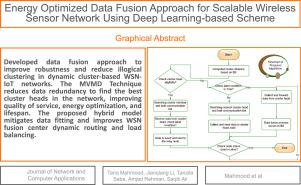当前位置:
X-MOL 学术
›
J. Netw. Comput. Appl.
›
论文详情
Our official English website, www.x-mol.net, welcomes your feedback! (Note: you will need to create a separate account there.)
Energy optimized data fusion approach for scalable wireless sensor network using deep learning-based scheme
Journal of Network and Computer Applications ( IF 8.7 ) Pub Date : 2024-02-01 , DOI: 10.1016/j.jnca.2024.103841 Tariq Mahmood , Jianqiang Li , Tanzila Saba , Amjad Rehman , Saqib Ali
Journal of Network and Computer Applications ( IF 8.7 ) Pub Date : 2024-02-01 , DOI: 10.1016/j.jnca.2024.103841 Tariq Mahmood , Jianqiang Li , Tanzila Saba , Amjad Rehman , Saqib Ali

|
Energy efficiency and security are critical components of Quality of Service (QoS) and remain a challenge in WSN-assisted IoT owing to its open and resource-limited nature. Despite intensive research on WSN-IoT, only a few have achieved significant levels of energy efficiency and load balancing on clustering nodes. This study proposes a novel approach for dynamic cluster-based WSN-IoT networks to enhance the network’s resilience using data fusion techniques and eliminate illogical clustering. The Mean Value and Minimum Distance Method identifies the optimal cluster heads within the network by reducing data redundancy, resulting in improved quality of service, energy optimization, and enhanced lifetime. The proposed fused deep learning-based data mining method (RNN-LSTM) mitigates the data fitting and enhances the dynamic routing and balancing load at the WSN fusion center. The novel approach splits the network into layers, assigning sensor nodes to each layer, drastically reducing latency, data transfers, and the fusion center’s overhead. Distinct experiments evaluated the suggested approach’s efficacy by varying the hidden layer nodes and signaling intervals. The empirical verdicts exhibit that the presented routing algorithms surpass state-of-the-art conventional routing systems in energy depletion, average latency, signaling overhead, cumulative throughput, and route heterogeneity.
中文翻译:

使用基于深度学习的方案的可扩展无线传感器网络的能量优化数据融合方法
能源效率和安全性是服务质量 (QoS) 的关键组成部分,并且由于其开放性和资源有限的性质,仍然是 WSN 辅助物联网的一个挑战。尽管对 WSN-IoT 进行了深入的研究,但只有少数研究在集群节点上实现了显着的能源效率和负载平衡水平。本研究提出了一种基于动态集群的 WSN-IoT 网络的新方法,利用数据融合技术增强网络的弹性并消除不逻辑的集群。平均值和最小距离方法通过减少数据冗余来识别网络内的最佳簇头,从而提高服务质量、优化能源并延长使用寿命。所提出的基于融合深度学习的数据挖掘方法(RNN-LSTM)减轻了数据拟合并增强了WSN融合中心的动态路由和平衡负载。这种新颖的方法将网络分成几层,为每一层分配传感器节点,从而大大减少延迟、数据传输和融合中心的开销。不同的实验通过改变隐藏层节点和信号间隔来评估所建议方法的功效。经验结论表明,所提出的路由算法在能量消耗、平均延迟、信令开销、累积吞吐量和路由异构性方面超越了最先进的传统路由系统。
更新日期:2024-02-01
中文翻译:

使用基于深度学习的方案的可扩展无线传感器网络的能量优化数据融合方法
能源效率和安全性是服务质量 (QoS) 的关键组成部分,并且由于其开放性和资源有限的性质,仍然是 WSN 辅助物联网的一个挑战。尽管对 WSN-IoT 进行了深入的研究,但只有少数研究在集群节点上实现了显着的能源效率和负载平衡水平。本研究提出了一种基于动态集群的 WSN-IoT 网络的新方法,利用数据融合技术增强网络的弹性并消除不逻辑的集群。平均值和最小距离方法通过减少数据冗余来识别网络内的最佳簇头,从而提高服务质量、优化能源并延长使用寿命。所提出的基于融合深度学习的数据挖掘方法(RNN-LSTM)减轻了数据拟合并增强了WSN融合中心的动态路由和平衡负载。这种新颖的方法将网络分成几层,为每一层分配传感器节点,从而大大减少延迟、数据传输和融合中心的开销。不同的实验通过改变隐藏层节点和信号间隔来评估所建议方法的功效。经验结论表明,所提出的路由算法在能量消耗、平均延迟、信令开销、累积吞吐量和路由异构性方面超越了最先进的传统路由系统。



























 京公网安备 11010802027423号
京公网安备 11010802027423号